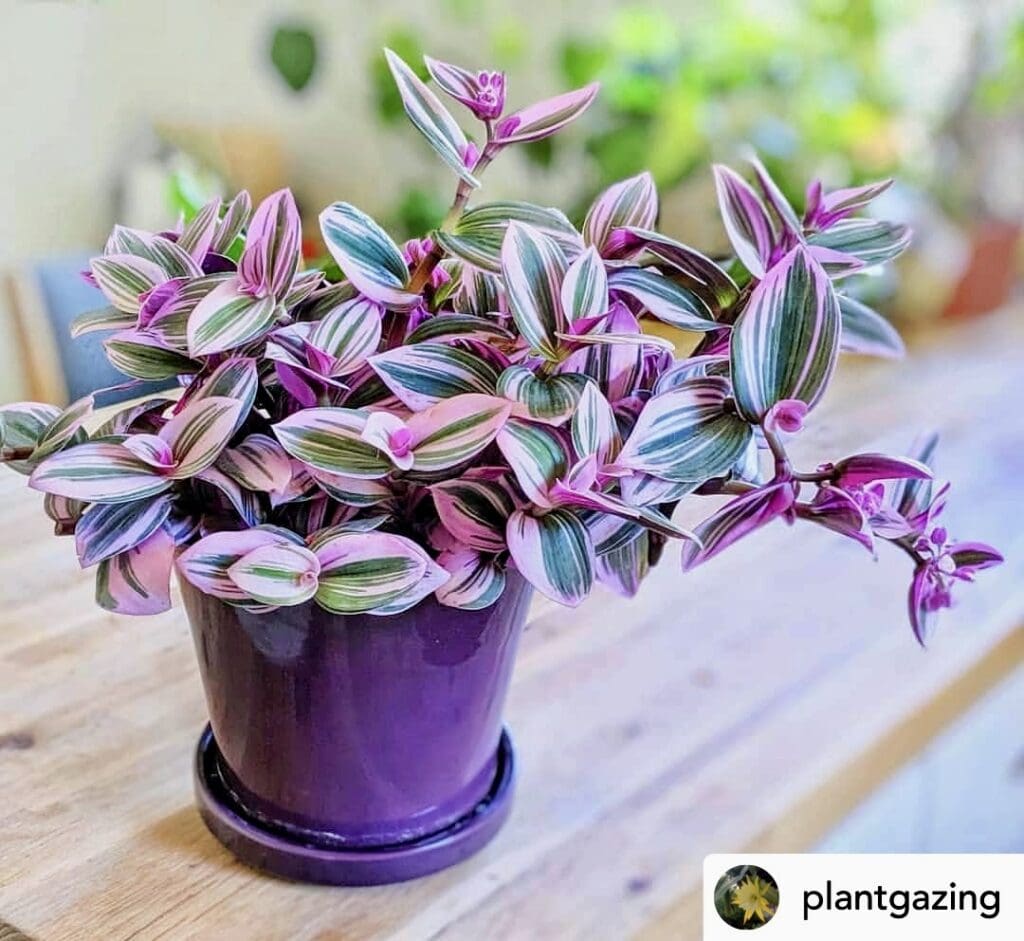Spiderwort Plant Care Guide: Grow a Lush Oasis Effortlessly!
Spiderworts, or as I like to call them, the laid-back friends of the plant world, are a magical addition to any indoor jungle.
I’ve found that these plants, with their sword-like leaves and charming three-petaled flowers, can really brighten up a room – and not just with their looks!
They’re wonderfully undemanding, making them perfect for both green thumbs and those who are, let’s say, botanically challenged. 😊
Ever had that friend who’s cool with whatever plans you make? That’s spiderwort in the plant world.
Whether it’s partial shade or a spot with indirect light, spiderwort’s chilled vibes are all about adapting.
They’re the epitome of “go with the flow,” thriving in well-draining potting soil with a pH of 6 to 8.
Honestly, taking care of these green buddies is a breeze.
I keep my soil moist (but not soggy, because no one likes wet feet, right?) and occasionally cut back the stems to keep things tidy and prevent any unwanted seeding.
Gardeners, have you had success with dividing and propagating these gems? Let’s swap stories in the comments! 🌱💬
Please note: Simplify Plants is reader-supported. As an Amazon Associate, I earn from qualifying purchases made by our readers with no extra cost added to you all! Some links in the post are affiliate links and I get a commission from purchases made through links in the post.
Understanding Spiderwort
Spiderwort plants, with their grass-like leaves and trio of petal blooms, have tickled my green thumb fancy since I first laid eyes on them.
They’re as easy to care for as they are charming, making them a delightful addition to any indoor plant collection.
Plant Origin and History
Have you ever wondered where these beauties came from?
Spiderwort, also known by its scientific name Tradescantia, hails from the New World—think the Americas! 🌎
Pioneering European botanists were fascinated with their vivid colors and used them as ornamental plants.
Here’s a fun fact for you: The unique name “Spiderwort” comes from the plant’s spider-like form when the leaves are cut and the sap creates silvery threads—not from any spider-tastic origin!
Types of Spiderwort
Now, hold onto your plant pots because there’s more than one type of Spiderwort. Imagine that! 🌱
Several species exist, but the ones you’re likely to invite into your home include the Tradescantia zebrina with its silver-striped leaves, Tradescantia fluminensis known for its solid green foliage, and the purple-hearted Tradescantia pallida.
Each type showcases its own signature leaf pattern and flower color. Which one matches your plant parent vibe? I’m a total zebrina fan—those stripes had me at hello!
So, fellow plant enthusiasts, which Spiderwort has stolen your heart? 🌿 Share it with me in the comments, and maybe we can start a Spiderwort fan club—first rule of Spiderwort club: always talk about Spiderwort club!
Potting and Soil Requirements

When it comes to keeping your Spiderwort happy, think of pots and soil as its personal real estate and a comfy mattress. Getting these right is like giving your plant its own little slice of paradise. 🌱
Choosing the Right Pot
I can’t stress enough how important it is to pick the right pot for your Spiderwort.
A good rule of thumb is to choose one that’s about an inch or two larger than the plant’s root ball. Make sure it has drainage holes – waterlogged roots are a no-go for these plants.
Trust me; a pot with good drainage is like VIP parking for your plant’s roots. They’ll thank you for it by growing lush and strong!
Here’s what to look for:
- Size: 1-2 inches bigger than the root ball.
- Drainage: Must-have drainage holes.
Soil Mix and pH Levels
Spiderwort isn’t picky, but it loves a well-draining potting mix with a pH that’s just a touch on the acidic side.
A pH of 6 to 8 is perfect for this easy-going plant.
If you’re mixing your own soil, a combination of peat, perlite, and garden soil is like a tailored suit for Spiderwort; it fits just right!
Quick soil check-list:
- Drainage is key: Grab a mix that won’t hold onto water for too long.
- pH perfection: Aim for a pH between 6 to 8 – think ‘Goldilocks zone’ for Spiderwort.
Did you find the perfect pot? Maybe mix your own soil? Let me hear your stories in the comments! Or better yet, share a pic of your Spiderwort living its best life! 📸
Light and Placement

In my journey of caring for Spiderwort, I’ve found that getting the light and placement right is like discovering the perfect spot on the couch – it makes all the difference! 🌞
Ideal Lighting Conditions
Spiderwort thrives in moderate to bright indirect light.
Direct sunlight? A big no-no – it’s like being at the beach without sunscreen; it can scorch its lovely leaves.
I keep mine near a window with a sheer curtain for that soft, diffused light it loves.
Best Locations Indoors
Have you ever moved a couch five times before finding the perfect spot? It’s the same with Spiderwort.
Look for a place that’s bright but out of direct sunlight. For me, an east-facing window ledge is the jackpot.
Spiderwort also enjoys the occasional view from a well-lit bathroom, as long as it doesn’t turn into a steam room – think bright, think airy! 💨
Now I’m curious, where have you found your Spiderwort likes best? Share your spot-on locations in the comments and let’s help each other out! 🌿👇
Watering and Humidity
Let’s dive right into the liquid love and misty moments your Spiderwort will absolutely adore! 💧
Watering Schedule
I’ve got the inside scoop: keep the soil consistently moist for a happy, hydrated Spiderwort.
I aim to water mine when the top inch of soil feels dry to the touch.
Here’s a little secret: during the summer, they’re a bit thirstier, so I check on them more often, maybe even entertain them with a little drink-sip-repeat routine every few days.
Remember, it’s like they always say, moderation is key—nobody likes overwatered, soggy roots!
Humidity Preferences
Spiderworts are pretty chill when it comes to humidity—they don’t need a tropical rainforest environment, but they do appreciate a little moisture in the air.
I sometimes mist my plant buddies lightly with a spray bottle, or place their pot on a tray filled with water and pebbles to keep their feet from getting wet while they soak up some ambient humidity.
If you’re feeling fancy, a small humidifier can be the piece de resistance to provide that perfect ambiance. Isn’t that just a breath of fresh air? 😌
So, what’s your Spiderwort’s drink of choice? Tap, filtered, perhaps a dash of rainwater? Share your watering wisdom in the comments below!
Temperature and Climate

When I dive into the world of indoor plant care, temperature and climate are my go-to’s for keeping my green buddies happy. Let’s not let our leafy friends shiver or sweat it out, okay?
Optimal Temperature Range
Spiderworts love to bask in the sweet spot of temperatures—not too hot, not too cold.
I’ve found that they thrive best when the mercury hovers between 65°F and 75°F.
That’s usually your typical indoor environment, isn’t it? 🌡️ Just remember, if you’re comfortable, chances are your spiderwort is too!
Adapting to Indoor Climate
Now, adapting your spiderwort to your home climate might sound like a high-maintenance relationship, but it’s surprisingly easy!
These plants are like the laid-back friends we all love—they’re not picky and easily adapt to indoor humidity levels.
Just keep them away from drafts and sudden temperature changes.
Have you ever seen a plant with a tiny sweater? No? That’s because they rely on us to keep their environment stable. 😄
Got any cool tips or fun stories about your spiderwort’s reaction to temperature changes? Let me know below!
Fertilizing and Nutrition

When I think about keeping my Spiderwort happy, I always pay extra attention to its diet. Just like us, plants need the right nutrients to flourish!
Suitable Fertilizers
Let’s talk fertilizers! 🌿
For my Spiderwort, I stick to liquid or water-soluble fertilizers. They’re like a quick snack that’s easy to digest.
I aim for a balanced 10-10-10 mix—that’s equal parts nitrogen, phosphorus, and potassium. Here’s a quick cheat sheet:
- Nitrogen (N): For lush green leaves
- Phosphorus (P): Strong root growth
- Potassium (K): Overall health and disease resistance
Feeding Frequency
Now, how often should you treat your Spiderwort to a meal? 🥄
I’ve found that once a month during the growing season (spring and summer) is the sweet spot. But during fall and winter? Give it a rest. They like a little diet to prepare for the next season’s growth spurt!
Remember, never to overfeed your leafy pals, and always water your Spiderwort before a fertilizer treat. Who doesn’t like to eat on a full stomach? 😄
What’s your go-to fertilizer for your indoor green buddies? Drop your tips and tricks in the comments—I’d love to hear from you! 🌟
Pruning and Maintenance
Keeping your Spiderwort thriving involves a bit of snipping and proper care. Trust me, it’s as easy as pie, and your green buddy will thank you for it with luscious growth. 🌿
Pruning Techniques
Pruning Spiderwort isn’t rocket science. I usually get my shears out in early spring or late winter.
Snip-snip! ✂️ It’s all about removing the old foliage to make way for the new.
Make sure your plant is dormant when you do this to give it enough time to bounce back.
Just cut back the stems to about 8 to 12 inches, and you’re golden! Remember to keep the pruning shears clean to avoid any pesky infections.
Regular Maintenance Tips
Now, for the day-to-day love your plant needs to thrive: watering and soil checks.
You’ll want to keep the soil moist, but not waterlogged. Think of it as a spa bath for your Spiderwort – it likes to stay hydrated, but it doesn’t want to swim! 🚿
Also, every three years, don’t forget to divide your plant to keep it from getting too crowded. It’s like giving it a bit more personal space in a crowded room.
Have you got any trimming triumphs or maintenance hacks up your sleeve? I’d love to hear them below! 👇 And if you found these tidbits helpful, give ’em a share – your plant-lover friends might just thank you for it. Happy gardening! 🌼
Pests and Diseases

Hey fellow green thumbs! 🌿 Ever had those “uninvited guests” on your Spiderwort plants or worried about those pesky plant sniffles? Let’s dive right into keeping those plants healthy and pest-free!
Common Pests
Spiderwort can sometimes play host to a bug bash, and I’m not talking about the fun kind!
Whiteflies are the gate-crashers to watch out for. These little winged troublemakers love to slurp on the underside of leaves. 🐛
You’ll spot them by the yellowing leaves and sticky honeydew residue they leave behind.
To send them packing, it’s best to use insecticidal soap or neem oil. Have any of you tried other remedies that worked? Let me know!
Disease Prevention
Preventing plant diseases is like brushing your teeth—do it well, and you’ll avoid cavities!
For our leafy pals, there are a couple of key things I do to keep them in tip-top shape.
First, I ensure they are planted in well-draining soil and I’m careful not to overwater.
Soggy roots can invite fungi to the party—no thanks! 🚫🍄
Also, giving your Spiderwort enough space to breathe prevents too much moisture buildup.
Remember, a happy plant is a healthy plant! Got any disease prevention tips of your own? Share them below!
Propagation
Isn’t it amazing how one Spiderwort plant can lead to a whole garden of them? I’m here to share the simple joys of propagation. Trust me, if I can do it, so can you!
Propagation Methods
When it comes to multiplying your Spiderwort, you’ve got some nifty tricks up your sleeve!
- Through Cuttings: I snip about 3 to 4 inches of the stem, just below a leaf node.
- Then I strip the bottom leaves and pop the stem into water or soil. Super easy, right?
- Division: This might sound like a math problem, but it’s actually simpler!
- In the fall or early spring, I just dig up the plant, split it into smaller clumps, and replant. Sharing is caring, after all!
- Layering: It’s like giving your Spiderwort a little test drive in a new soil before fully moving in.
- Bend a stem down to the soil, secure it, and once it roots, snip and you have a new plant!
I tend to prefer water propagation, because watching those tiny roots sprout is pretty magical. 🌱
Have you tried it? Which method do you think is the easiest?
Growth Stages
The journey of a Spiderwort cutting becoming a full-grown plant has a few stages, and it’s quite a sight to behold!
- Rooting: Usually takes about a week or two in water. I make sure to change the water every few days to keep it fresh.
- Potting: Once the roots are a couple of inches long, I transfer my water-rooted cuttings to soil.
- When potting, I remind myself not to bury the leaves!
- Maturing: It takes a few weeks for the plant to really settle into its new home. I watch as it grows taller and fuller, and before I know it, it’s time to propagate again! 🌸
Did you find potting as thrilling as I did? I’d love to hear about your “root” to success! Share your propagation tales below.
Repotting
As a plant parent, I know that giving my Spiderwort a new home every so often is key to keeping it thriving. Let’s dive into the potting soil and get our hands dirty—it’s repotting time!
Signs for Repotting
Have you checked your Spiderwort’s roots lately?
If they’re poking out of the drainage holes or the soil dries quicker than a comedian’s wit, it’s a telltale sign that your green buddy is ready for a bigger space.
Another clue is if the plant growth has slowed down significantly—it’s like your plant is saying, “Hey, I need a room upgrade!”
Repotting Step-by-Step
Let me share the steps I follow when it’s time to repot:
- Choose a new pot that’s about one size larger than the current one—usually 1-2 inches more in diameter.
- Lay down some fresh potting mix at the bottom of the new pot. This is the comfy new mattress for your plant’s roots.
- Gently coax your Spiderwort out of its current pot. I like to give the bottom a soft tap—it’s like ringing the bell for checkout.
- Have a look at the roots and trim any that are damaged or too long.
- Place your Spiderwort in the center of its new pot and fill in around the roots with more potting mix.
- Remember not to pack the soil tighter than a jam-packed elevator.
- Give it a good watering to help it settle in. This is like a welcome drink for your plant’s roots!
Remember not to go too big with the pot; it’s a cozy cottage we’re aiming for, not a mansion! 🏡
And there you have it! Who knew repotting could be as easy as baking a cupcake—well, maybe a tad messier, but just as satisfying! 🌱
Got any Spiderwort repotting stories? Drop them in the comments—I’d love to hear about your plant adventures!
Troubleshooting
Hey fellow plant enthusiasts! Ever noticed your Spiderwort looking a bit sadder than usual? Here’s the scoop on how to perk ’em up!
Yellow Leaves
Have you spotted yellow leaves on your Spiderwort? First off, don’t panic! 🌿
I always check if I’m over-watering, because too much H2O can turn those green beauties yellow.
Make a schedule, stick to it, and give your plant a drink only when the top inch of soil is dry.
Another culprit could be low light – these plants love their bright indirect sunshine!
Drooping Stems
If your Spiderwort’s stems are drooping, it’s like a little cry for help.
Start by observing—am I watering too much or too little? 🤔
Water consistently, folks!
Also, giving your plant a boost with a well-balanced fertilizer during the growing season can lift their spirits… and stems!
Just like a good pep talk can cheer us up, a little plant-food pep talk can do wonders for your Spiderwort.
FAQs on Spiderwort Care

What’s the best way to water my Spiderwort?
Watering Spiderwort is a breeze! They like their soil moist, but don’t go overboard.
I stick my finger in the soil, and if the top inch is dry, it’s time to water.
Remember, they’re not fans of wet feet, so ensure good drainage to avoid sogginess. 💦
How often should I fertilize?
Spiderwort isn’t super picky, but feeding it every month during the growing season with a balanced fertilizer helps it flourish.
Just think of it as giving your plant a little monthly treat! 🍽️
When’s the right time to repot?
Feel like your Spiderwort is getting cramped?
Give it a new home every couple of years or when it seems contained. Spring is the best time for repotting, just before the growth spurt! 🌱
Can I propagate Spiderwort easily?
Propagating Spiderwort is like making plant babies, and it’s super easy!
Divide large clumps in the fall or early spring. Or, fancy taking cuttings? That’s cool too. They’ll root in soil in no time. I often share the love with friends. 🌸
Does it bloom indoors?
Yes, it sure does!
Spiderwort rewards you with lovely blooms indoors, provided they get enough light. If you’re not seeing flowers, maybe it’s time for a brighter spot? 🌞
Got more questions, or tips to share from your Spiderwort adventure? Drop them in the comments! Let’s grow together! 🌿🤗
Conclusion
Growing Spiderwort indoors has been quite the adventure, hasn’t it?
Who knew a plant could bring such a splash of color and life into our spaces? 😊
Did you find the right spot with that perfect light?
I hope your Spiderwort is thriving in its cozy corner, rocking out to your morning playlist. 🎶
Remember, they’re not too picky, but they flourish in bright, indirect light and a bit of pampering with consistent moisture.
Watering—how’s it going?
Getting into the rhythm of keeping the soil moist (but not soggy!) is like learning a new dance step, right? 💃
I bet you’re a pro by now, giving it just enough to drink without overdoing it.
Let’s not forget those biannual spa days!
Giving your plant a trim after flowering keeps it looking fresh and inhibits unwanted seeding.
It’s like a haircut for better growth—except, well, for a plant. ✂️🌱
And did you try dividing your Spiderwort?
If you did, give yourself a pat on the back! You’ve multiplied the joy without even visiting the garden center.
Who knew we could become plant parents just by bringing a Spiderwort inside?
If you’ve got tips, tricks, or a fun story about your plant, I’d love to hear it!
Share in the comments and let’s keep this green thumb party going! 🌿🎉
Recommended Garden Supplies
| Product Image | Our Recommended Gardening Supplies | Check Offers! |
|---|---|---|
Top Top
Top
Top
Top
Top
Top
Top
Top | rePotme Houseplant and Tropical Classic Potting Soil Mix | Check Offer On Amazon |
 Top
Top
Top
Top
Top
Top
Top
Top | Espoma Organic Indoor Plant Food | Check Offer On Amazon |
 Top
Top
Top
Top
Top
Top
Top
Top | GooingTop LED Grow Light 6000K Full Spectrum Clip Plant Growing Lamp | Check Offer On Amazon |
 Top
Top
Top
Top
Top
Top
Top
Top | Soil Moisture Meter | Check Offer On Amazon |
 Top
Top
Top
Top
Top
Top
Top
Top | Govee Hygrometer Thermometer, Bluetooth Enabled! | Check Offer On Amazon |
 Top
Top | LEVOIT Humidifiers for Large Room(Best For Plants) | Check Offer On Amazon |
 Top
Top
Top
Top
Top
Top
Top
Top | Upgraded DIY Automatic Drip Irrigation Kit, 15 Potted Houseplants Support | Check Offer On Amazon |
 Top
Top
Top
Top
Top
Top
Top
Top | Stainless Steel Heavy Duty Gardening Tool Set | Check Offer On Amazon |
 Top
Top
Top
Top
Top
Top
Top
Top | Bonide Insecticidal Soap | Check Offer On Amazon |
 Top
Top
Top
Top
Top
Top
Top
Top | Bonide 32 oz Spray Neem Oil for Organic Gardening | Check Offer On Amazon |
 Top
Top
Top
Top
Top
Top
Top
Top | Garden Safe Fungicide | Check Offer On Amazon |






